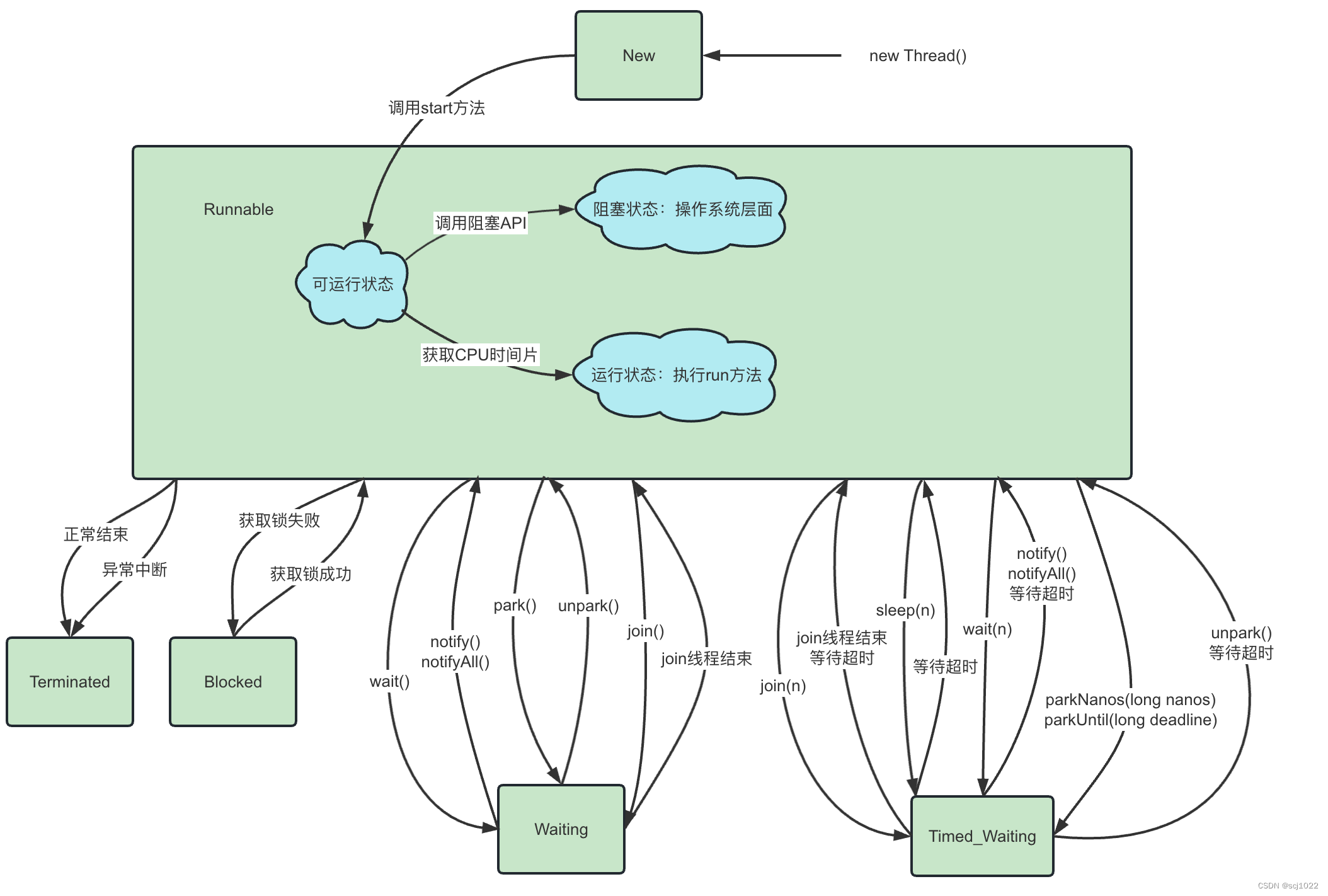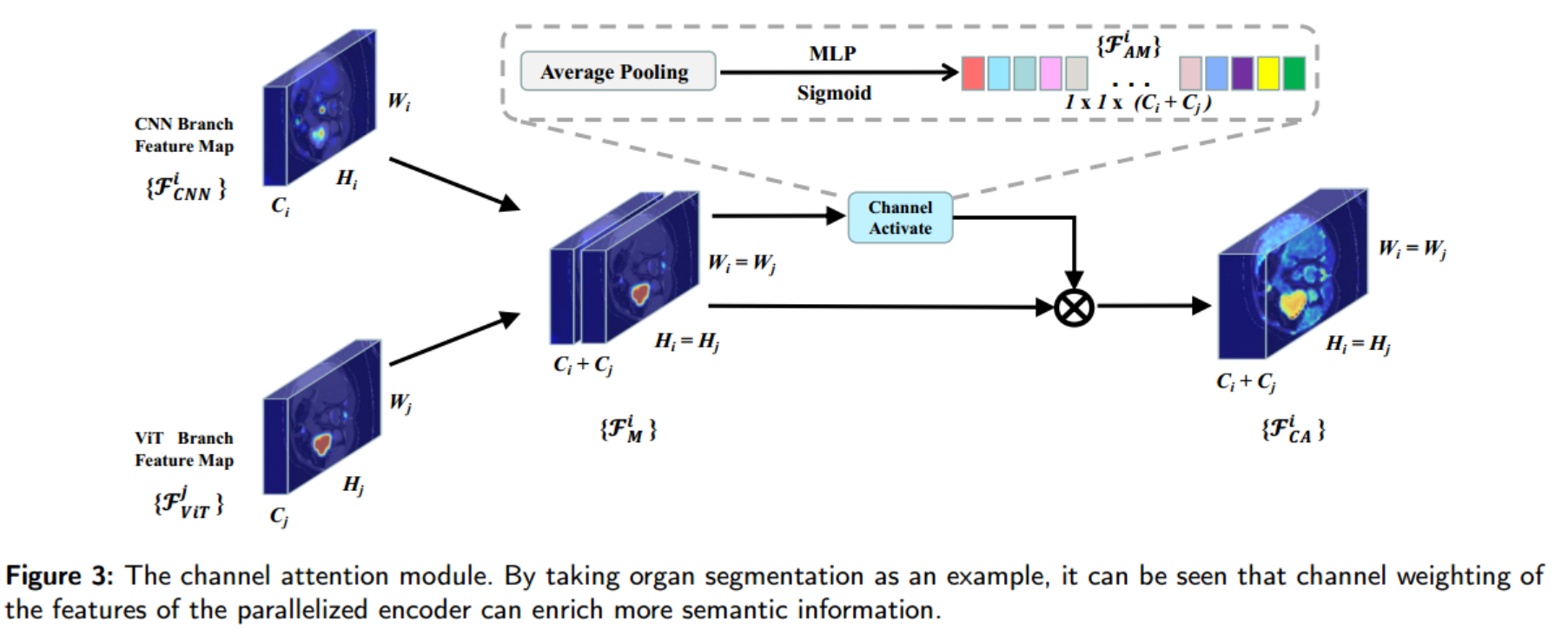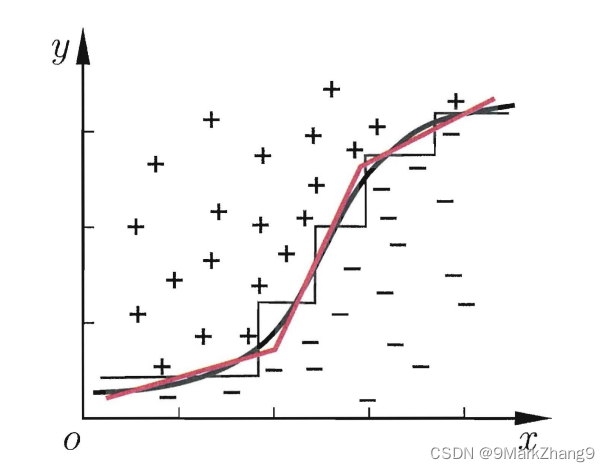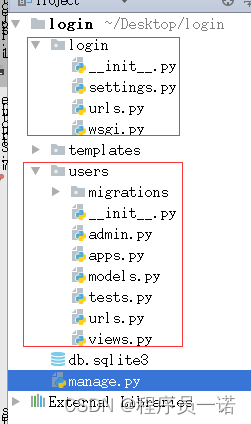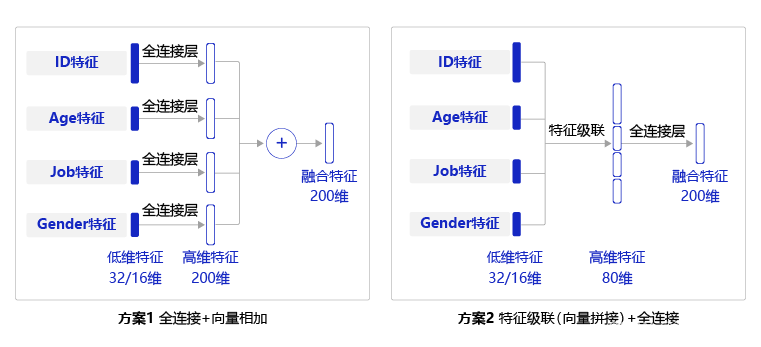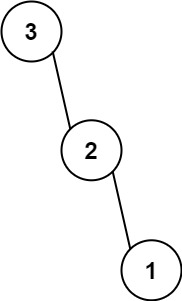文章目录
- 线程的状态与切换
- 一、线程的状态
- 1、操作系统层面(5种)
- 2、Java_API层面(6种)
- 二、让出时间片 - yield
- 三、线程插队 - join
- 1、源码分析
- 2、应用1 - 等待线程结果
- 3、应用2 - 控制执行顺序
- 四、计时等待 - sleep
- 五、等待唤醒 - wait & notify
- 1、相关API
- 2、工作原理
- 3、wait 和 sleep 的区别
- 4、案例 - 基本使用
- 5、案例 - if 还是 while
- 6、案例 - 交替打印奇偶数
- 7、案例 - 生产者消费者
- 六、等待唤醒 - park & unpark
- 1、相关API
- 2、使用案例
- 3、工作原理
- 4、park 和 wait 的区别
- 七、等待唤醒 - Condition
- 1、相关API
- 2、使用案例 - 顺序打印
- 八、线程中断 - interrupt & stop
- 1、中断线程的两种方式
- 1)stop
- 2)interrupt
- 2、中断相关API
- 1)interrupt
- 2)isInterrupted
- 3、打断正常运行的线程
- 4、打断sleep、wait、join的线程
- 1)打断 sleep
- 2)打断 wait
- 3)打断 join
- 5、打断 park 的线程
- 6、案例:两阶段中止模式
- 九、线程状态与切换小结
线程的状态与切换
一、线程的状态
线程的状态指的是:线程在执行过程中所处的不同阶段。
1、操作系统层面(5种)
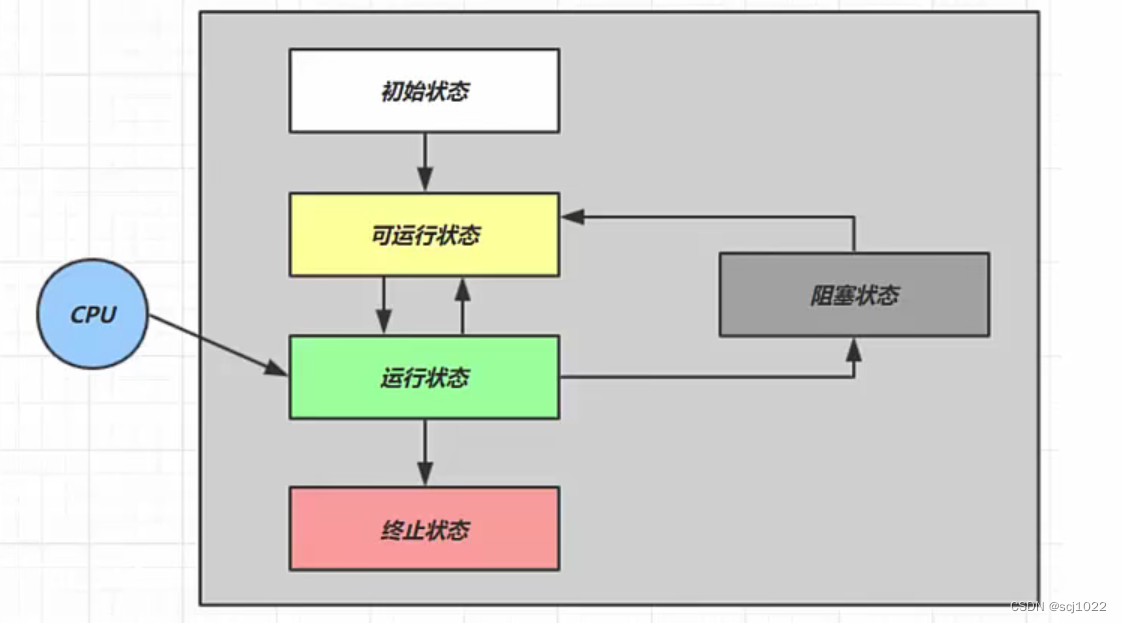
从操作系统层面,线程可分为 5种 状态:
-
初始状态
仅仅是在语言层面上创建了线程对象,还未与操作系统线程关联。
-
可运行状态
线程已创建,并且与操作系统相关联,可以由CPU调度执行。
当被cpu分配了时间片,会从
可运行状态转换至运行状态 -
运行状态
线程获取了cpu时间片,正在运行。
当cpu时间片用完,会从
运行状态转换至可运行状态,发生上下文切换。 -
阻塞状态
如果调用了阻塞API,如BIO读写文件,线程就会进入
阻塞状态如果调用了唤醒API,会由操作系统唤醒阻塞的线程,转换至
可运行状态与
可运行状态的区别是:任务调度器不会分配时间片给阻塞状态的线程 -
终止状态
表示线程已经执行完毕,生命周期已经结束,不会再转换为其它状态。
2、Java_API层面(6种)
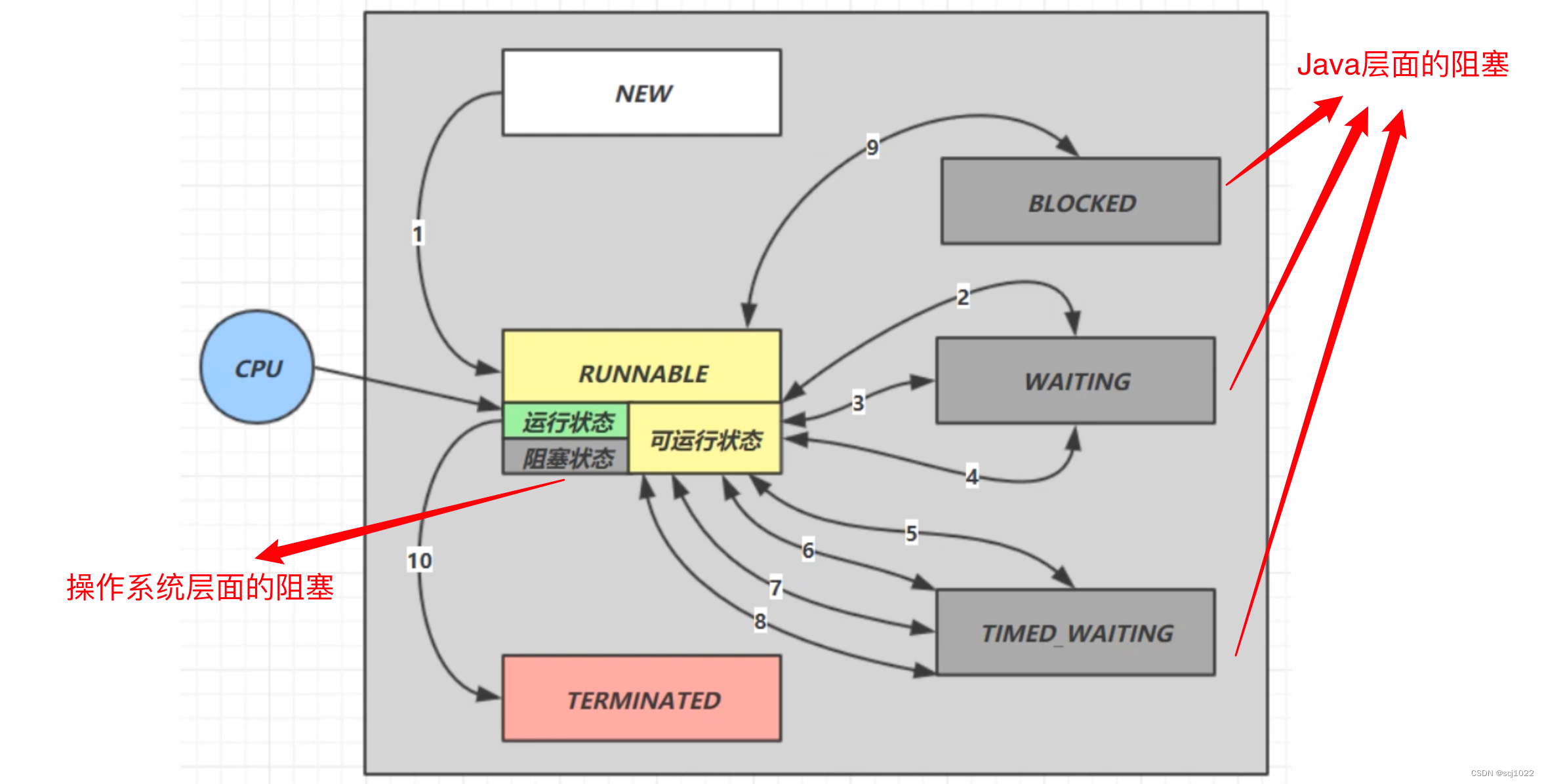
在java.lang.Thread.State枚举类中,给出了6种线程状态:
-
NEW - 新建
线程对象刚被创建(
new Thread()),还没有开始执行(调用start()方法) -
RUNNABLE - 可运行/就绪
-
可运行状态调用了
start()方法,Java的线程对象就和操作系统的线程关联起来,CPU就可以调度线程执行run()方法。 -
运行状态线程获得了CPU时间片,真正开始执行
run()方法。 -
阻塞状态调用了操作系统的阻塞API(注意:这里的阻塞是操作系统层面的,和 BLOCKED 不一样)
-
-
BLOCKED - 阻塞
当线程试图获取一个锁对象,而该对象锁被其他线程持有时,该线程会进入
阻塞状态(获取到锁则变为可运行状态) -
WAITING - 无限等待
线程因为调用了不带超时参数的
wait()、join()方法而被挂起,进入无限等待状态。必须等 其他线程调用
notify或notifyAll方法唤醒 或join的线程执行完,才会变为可运行状态 -
TIMED_WAITING - 计时等待
线程因为调用了带有超时参数的
wait()、sleep()或者join()方法而被挂起,进入计时等待状态。这一状态会一直保持到 设置的时间到达 或 接收到唤醒通知
notify/notifyAll。 -
TERMINATED - 死亡/终止
线程 执行完其任务 或者 因异常退出而结束。
二、让出时间片 - yield
Thread类的静态方法 yield(),该方法会使当前线程让出CPU的使用权。
// 使当前线程主动让出当前CPU时间片,回到「可运行状态」,等待分配时间片。
public static native void yield();
yield() 方法的调用不会导致当前线程阻塞,它只是让当前线程暂停执行,转变为可运行状态。因此,执行完yield() 方法之后,两个线程可能会交替执行,也可能一个线程执行完了才轮到另一个线程执行,这取决于操作系统的调度策略。
三、线程插队 - join
Thread类的方法join(),会使当前线程阻塞,等待调用join方法的线程运行(插队),可以控制线程执行顺序。
// 等待调用join方法的线程运行,直到该线程运行结束(默认millis=0)
public final void join() throws InterruptedException {
join(0);
}
// 等待调用join方法的线程运行,最多等待n毫秒
public final synchronized void join(long millis) throws InterruptedException {...}
1、源码分析
public final synchronized void join(long millis) throws InterruptedException {
// 开始时间
long base = System.currentTimeMillis();
// 经历的时间
long now = 0;
if (millis < 0) {
throw new IllegalArgumentException("timeout value is negative");
}
if (millis == 0) {
// 判断插队线程是否执行结束
while (isAlive()) {
wait(0);
}
} else {
while (isAlive()) {
// 剩余等待时间 = 最大等待时间 - 经历的时间
long delay = millis - now;
if (delay <= 0) {
break;
}
// 此处不为 millis 是为了避免虚假唤醒导致多余等待
wait(delay);
now = System.currentTimeMillis() - base;
}
}
}
2、应用1 - 等待线程结果
public class GetResult {
static int result = 0;
public static void main(String[] args) throws InterruptedException {
Thread t1 = new Thread(() -> {
try {
Thread.sleep(1000);
result = 100;
} catch (InterruptedException e) {
e.printStackTrace();
}
}, "t1");
t1.start();
// 等待t1线程执行结束再获取结果
t1.join();
System.out.println(result);
}
}
3、应用2 - 控制执行顺序
现在有T1、T2、T3三个线程,怎样保证T2在T1执行完后执行,T3在T2执行完后执行
public class RunInOrder {
public static void main(String[] args) {
Thread t1 = new Thread(() -> {
System.out.println("t1线程开始执行");
for (int i = 0; i < 10; i++) {
System.out.println("t1 ========> " + i);
}
});
Thread t2 = new Thread(() -> {
// t2线程执行时,t1线程插队
try {
t1.join();
} catch (InterruptedException e) {
e.printStackTrace();
}
for (int i = 0; i < 10; i++) {
System.out.println("t2 ========> " + i);
}
});
Thread t3 = new Thread(() -> {
// t3线程执行时,t2线程插队
try {
t2.join();
} catch (InterruptedException e) {
e.printStackTrace();
}
for (int i = 0; i < 10; i++) {
System.out.println("t3 ========> " + i);
}
});
t1.start();
t2.start();
t3.start();
}
}
四、计时等待 - sleep
Thread类的静态方法 sleep(),该方法会使当前线程进入计时等待状态指定毫秒。
// 使当前正在执行的线程以指定的毫秒数暂停,进入Timed Waiting状态
public static native void sleep(long millis) throws InterruptedException;
等待指定毫秒后,当前线程会自动唤醒,从计时等待状态进入可运行状态,等待分配时间片。
注意事项:
- 任务调度器不会把时间片分配给【阻塞状态】的线程。
- 其它线程可以使用 interrupt 方法打断正在睡眠的线程,这时 sleep 方法会抛出 InterruptedException
五、等待唤醒 - wait & notify
1、相关API

- wait 和 notify 是 Object 中的 等待唤醒方法,可以实现多个线程之间的协作。
- 必须获得此对象的锁,才能调用这几个方法。(在 同步方法 或 同步代码块 中)
- wait 方法会释放对象的锁,使线程进入 Monitor 的 WaitSet 等待区,从而让其他线程就机会获取对象的锁。
- notify 方法的唤醒是随机的,如果 Monitor 的 WaitSet 等待区有多个线程,notify 会随机选择一个唤醒。(竞争锁)
2、工作原理
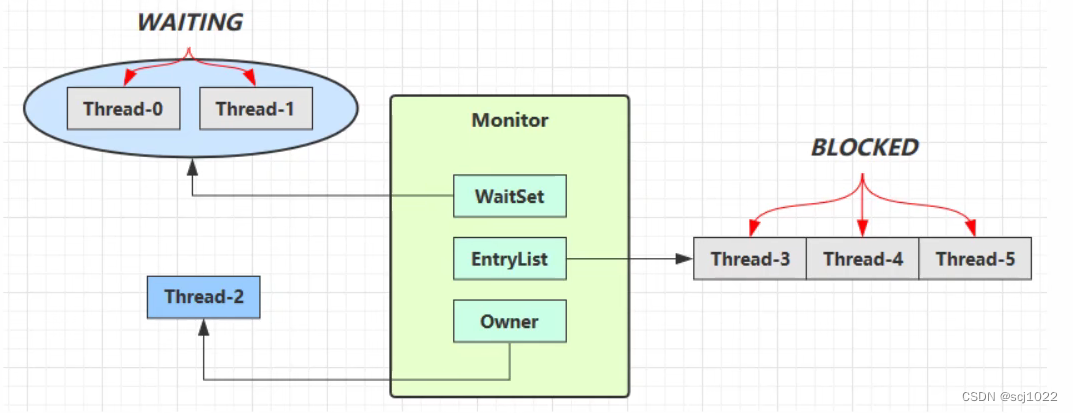
每个Java对象都可以关联一个Monitor,Monitor中同一时刻只能有一个Owner
-
刚开始时 Monitor 中的 Owner 为 null
-
当 Thread-2 执行 synchronized 代码块时,会将 Monitor 的所有者 Owner 设置为 Thread-2,上锁成功。
-
当 Thread-2 占据锁时,如果 Thread-3,Thread-4 也来执行 synchronized 代码块,就会进入 EntryList中,变成 BLOCKED 状态
BLOCKED 线程会在 Owner 线程释放锁时唤醒
-
Owner 线程调用 wait 方法,即可进入 WaitSet 变为 WAITING 状态。
WAITING 线程会在 Owner 线程调用 notify 或 notifyAll 时唤醒,但唤醒后并不意味者立刻获得锁,仍需进入EntryList 重新竞争
3、wait 和 sleep 的区别
sleep() 和 wait() 都是使线程暂停执行一段时间的方法,二者的区别为:
【工作原理】
sleep()方法是Thread类的静态方法,是线程用来控制自身流程的- 它会使此线程暂停执行一段时间,而把执行机会让给其他线程,等到计时时间一到,此线程会自动苏醒。
wait()方法是Object类的方法,用于线程间的通信,它会使当前拥有对象锁的线程进入等待- 没有指定时间:直到其他线程用调用
notify()或notifyAll()时,线程才会苏醒。 - 指定计时时间:被其他线程唤醒 或 等计时时间到了自动苏醒
- 没有指定时间:直到其他线程用调用
【锁的处理】
sleep()方法的主要作用是让线程暂停一段时间,让出CPU给其他线程,但是线程的监控状态依然保持着,时间一到则自动恢复,不涉及线程间的通信,因此调用sleep()方法不会释放锁。wait()方法则不同,当调用wait()方法后,线程会释放掉它所占用的锁,进入等待状态,从而使线程所在对象中的其他synchronized数据可以被别的线程使用。
【使用方面】
sleep()方法可以在任何地方使用,而wait()方法必须在 同步方法 或 同步代码块中 使用。sleep()的过程中,有可能被其他对象调用它的interrupt(),产生InterruptedException异常。- 由于
sleep()不会释放锁标志,容易导致死锁问题的发生。一般情况下,推荐使用wait()方法。
4、案例 - 基本使用
public class WaitAndNotifyTest {
public static void main(String[] args) {
Object lockObj = new Object();
new Thread(() -> {
synchronized (lockObj) {
System.out.println("A线程获取了锁,准备wait");
try {
lockObj.wait(); // 无限等待
} catch (InterruptedException e) {
e.printStackTrace();
}
System.out.println("A线程被唤醒,并且获取了锁");
}
}, "A线程").start();
new Thread(() -> {
String currentThread = Thread.currentThread().getName();
// 确保A线程先获取锁
try {
Thread.sleep(2000);
} catch (InterruptedException e) {
e.printStackTrace();
}
synchronized (lockObj) {
System.out.println("B线程获取了锁,准备唤醒A线程");
lockObj.notify(); // 唤醒A线程
System.out.println("B线程唤醒了A线程,还没有释放锁");
}
System.out.println("B线程释放了锁");
}, "B线程").start();
}
}
5、案例 - if 还是 while
class Number {
private int num = 0;
public synchronized void increment() throws InterruptedException {
while (num == 0) {
this.wait();
}
num++;
System.out.println(Thread.currentThread().getName() + ":" + num);
this.notifyAll();
}
}
在多线程中,判断必须使用 while,使用 if 存在虚假唤醒问题,如下:
if (num == 0) {
// 假设多个线程在这里wait
// 如果使用if的话,线程被唤醒后,不会再次进行num == 0判断,这样就会导致num++多次。
// 如果使用while的话,线程被唤醒以后,会再次进行条件判断,则不会出现这样的问题。
this.wait();
}
num++;
6、案例 - 交替打印奇偶数
/**
* 使用 wait 和 notify 实现两个线程 交替打印1到100
* 一个线程专门打印奇数 odd
* 一个线程专门打印偶数 even
*/
public class PrintOddAndEven {
public static void main(String[] args) {
NumberMode numberMode = new NumberMode();
new Thread(new PrintOdd(numberMode)).start(); // 奇数打印线程
new Thread(new PrintEven(numberMode)).start(); // 偶数打印线程
}
static class NumberMode {
public int num = 1;
}
// 奇数线程任务
static class PrintOdd implements Runnable {
NumberMode numberMode;
public PrintOdd(NumberMode numberMode) {
this.numberMode = numberMode;
}
@Override
public void run() {
while (numberMode.num < 100) {
synchronized (numberMode) {
if (numberMode.num % 2 != 0) {
// 打印奇数
System.out.println("奇数:" + numberMode.num);
numberMode.num++;
numberMode.notify();
} else {
try {
System.out.println("奇数线程休息");
numberMode.wait();
} catch (InterruptedException e) {
e.printStackTrace();
}
}
}
}
}
}
// 偶数线程任务
static class PrintEven implements Runnable {
NumberMode numberMode;
public PrintEven(NumberMode numberMode) {
this.numberMode = numberMode;
}
@Override
public void run() {
while (numberMode.num < 100) {
synchronized (numberMode) {
if (numberMode.num % 2 == 0) {
// 打印偶数
System.out.println("偶数:" + numberMode.num);
numberMode.num++;
numberMode.notify();
} else {
try {
System.out.println("偶数线程休息");
numberMode.wait();
} catch (InterruptedException e) {
e.printStackTrace();
}
}
}
}
}
}
}
7、案例 - 生产者消费者
生产者消费者模式是并发编程中经典的模式。生产者和消费者通过分离的执行工作解耦,以不同的速度生产和消费数据。
生产者消费者模式的好处:
- 简化了开发,你可以独立的或并发的编写消费者和生产者,它仅仅只需知道共享对象是谁。
- 生产者不需要知道谁是消费者或者有多少消费者,对消费者来说也是一样。
- 生产者和消费者可以以不同的速度执行。
- 分离的消费者和生产者在功能上能写出更简洁、可读、易维护的代码。
【案例分析】
public class ProducerConsumerMode {
public static void main(String[] args) {
List<String> dish = new ArrayList<>(); // 盘子
new Thread(new Producer(dish)).start(); // 生产者
new Thread(new Consumer(dish)).start(); // 消费者
}
/**
* 消费者:吃包子
*/
static class Consumer implements Runnable {
private final List<String> dish;
public Consumer(List<String> dish) {
this.dish = dish;
}
@Override
public void run() {
while (true) {
synchronized (dish) {
// 如果盘子中没包子,等待,叫师傅做包子
if (dish.isEmpty()) {
try {
dish.wait();
} catch (InterruptedException e) {
e.printStackTrace();
}
}
String food = dish.remove(0); // 从盘子中取出包子
try {
Thread.sleep(50); // 吃包子的时间
} catch (InterruptedException e) {
e.printStackTrace();
}
System.out.println("吃货吃包子:" + food + " 盘子中剩余:" + dish.size());
// 通知师傅做包子
dish.notify();
}
}
}
}
/**
* 生产者:卖包子
*/
static class Producer implements Runnable {
private int count = 0;
private final List<String> dish;
public Producer(List<String> dish) {
this.dish = dish;
}
@Override
public void run() {
// 生产包子的逻辑
while (true) {
// 生产者和消费者使用的是同一个集合,可以当做锁对象使用
synchronized (dish) {
// 如果盘子中包子数量已达100
if (dish.size() >= 100) {
// 师傅休息,等待吃货吃包子
try {
dish.wait();
} catch (InterruptedException e) {
e.printStackTrace();
}
}
// 做包子
count++;
try {
// 模拟做包子的时间
Thread.sleep(50);
} catch (InterruptedException e) {
e.printStackTrace();
}
dish.add("[" + count + "]"); //放到盘子中
System.out.println("包子铺师傅做包子:" + "[" + count + "] 盘子中还剩:" + dish.size());
dish.notify(); // 通知吃货去吃包子
}
}
}
}
}
六、等待唤醒 - park & unpark
1、相关API
park 和 unpark 是 JUC并发包中,LockSupport类的静态方法
public class LockSupport {
private static final sun.misc.Unsafe UNSAFE;
// 暂停当前线程
public static void park() {
UNSAFE.park(false, 0L);
}
// 恢复某个线程的运行
public static void unpark(Thread thread) {
if (thread != null)
UNSAFE.unpark(thread);
}
}
package sun.misc;
public final class Unsafe {
public native void park(boolean isAbsolute, long time);
public native void unpark(Object thread);
}
2、使用案例
/**
* 先 park 再 unpark(park的时候会阻塞,然后unpark时被唤醒)
*/
public class ParkAndUnparkTest1 {
public static void main(String[] args) throws InterruptedException {
Thread t1 = new Thread(() -> {
System.out.println("park...");
LockSupport.park(); // 此处会暂停,然后被unpark唤醒
System.out.println("resume...");
}, "t1");
t1.start();
Thread.sleep(2000);
System.out.println("unpark...");
LockSupport.unpark(t1);
}
}
/**
* 先 unpark 再 park(这种情况,park的时候是不会停止的)
*/
public class ParkAndUnparkTest2 {
public static void main(String[] args) throws InterruptedException {
Thread t1 = new Thread(() -> {
try {
Thread.sleep(2000);
} catch (InterruptedException e) {
throw new RuntimeException(e);
}
System.out.println("park...");
LockSupport.park(); // 此处不会暂停,会直接往下执行
System.out.println("resume...");
}, "t1");
t1.start();
Thread.sleep(1000);
System.out.println("unpark...");
LockSupport.unpark(t1);
}
}
3、工作原理
每个线程都有自己的一个 Parker 对象,由三部分组成 _counter 、_cond 、 _mutex 。
打个比喻,线程是旅行者,Parker是携带的背包, _cond 是休息的帐篷,_mutex 是帐篷的锁,_counter是干粮(0耗尽 1充足)
- 调用 park ,就是要看需不需要停下来歇息
- 如果备用干粮耗尽(
_counter=0),那么钻进帐篷_cond歇息,并上锁_mutex - 如果备用干粮充足(
_counter=1),那么不需停留,继续前进
- 如果备用干粮耗尽(
- 调用 unpark,就好比补充干粮(
_counter=1)- 如果这时线程还在帐篷
_cond休息,就唤醒让他继续前进 - 如果这时线程还在运行,那么下次他调用 park 时,仅是消耗掉备用干粮(
_counter=0),不需停留继续前进 - 因为背包空间有限,多次调用 unpark 仅会补充一份备用干粮(
_counter最大为1)
- 如果这时线程还在帐篷
4、park 和 wait 的区别
-
wait 和 notify 是 Object 中的等待唤醒方法;park 和 unpark 是 JUC并发包 中 LockSupport 类的静态方法
-
wait 和 notify 必须在 同步方法 或 同步代码块 中使用;而 park 和 unpark 不必。
-
park 和 unpark 可以【阻塞】和【唤醒】指定的线程,
notify 是 随机唤醒一个等待线程,notifyAll 是唤醒所有等待线程。
-
park 和 unpark 可以先 unpark,而 wait 和 notify 不能先 notify
七、等待唤醒 - Condition
1、相关API
Condition 是 JUC包中的等待唤醒,通过和Lock的组合使用,实现精准的等待和唤醒
Condition 取代了对象监视器方法的使用
public interface Condition {
// 等待
void await() throws InterruptedException;
void awaitUninterruptibly();
long awaitNanos(long nanosTimeout) throws InterruptedException;
boolean await(long time, TimeUnit unit) throws InterruptedException;
boolean awaitUntil(Date deadline) throws InterruptedException;
// 唤醒
void signal();
void signalAll();
}
Lock 取代了 synchornized 方法和语句
public interface Lock {
// 获取监视器实例
Condition newCondition();
}
2、使用案例 - 顺序打印
public class ConditionTest {
public static void main(String[] args) {
Print print = new Print();
new Thread(() -> {for (int i = 0; i < 5; i++) print.printA();}, "A").start();
new Thread(() -> {for (int i = 0; i < 5; i++) print.printB();}, "B").start();
new Thread(() -> {for (int i = 0; i < 5; i++) print.printC();}, "C").start();
}
}
class Print {
private int number = 1;
// Lock锁对象
private ReentrantLock lock = new ReentrantLock();
// Condition对象
private Condition condition1 = lock.newCondition();
private Condition condition2 = lock.newCondition();
private Condition condition3 = lock.newCondition();
public void printA() {
// 1. 加锁
lock.lock();
try {
// 2. 判断等待
if (number != 1) {
condition1.await();
}
// 3. 业务代码
System.out.println(Thread.currentThread().getName() + "=> AAA");
number = 2;
// 4. 指定唤醒
condition2.signal();
} catch (Exception e) {
e.printStackTrace();
} finally {
// 5. 解锁
lock.unlock();
}
}
public void printB() {
lock.lock();
try {
if (number != 2) {
condition2.await();
}
System.out.println(Thread.currentThread().getName() + "=> BBB");
number = 3;
condition3.signal();
} catch (Exception e) {
e.printStackTrace();
} finally {
lock.unlock();
}
}
public void printC() {
lock.lock();
try {
if (number != 3) {
condition3.await();
}
System.out.println(Thread.currentThread().getName() + "=> CCC");
number = 1;
condition1.signal();
} catch (Exception e) {
e.printStackTrace();
} finally {
lock.unlock();
}
}
}
八、线程中断 - interrupt & stop
1、中断线程的两种方式
1)stop
之前的做法:Thread.currentThread().stop(); (由于安全问题已弃用)
- 通过抛出
ThreadDeath的Error来达到停止线程的目的,Error的抛出可能发生在程序的任何一个地方。
public class Thread implements Runnable {
@Deprecated
public final void stop() {
// ...
// The VM can handle all thread states
stop0(new ThreadDeath());
}
private native void stop0(Object o);
}
public class ThreadDeath extends Error {
private static final long serialVersionUID = -4417128565033088268L;
}
由于抛出ThreadDeatch异常,会导致该线程释放所持有的锁,而这种释放的时间点是不可控的,可能会导致出现线程安全问题和数据不一致情况,比如在同步代码块中在执行数据更新操作时线程被突然停止。
2)interrupt
现在的做法:Thread.currentThread().interrupt();
- 将中断标记置为true,并不会使线程立即停止(可以通过
isInterrupted判断中断状态,来使线程停止)
public class Thread implements Runnable {
// 将中断标记置为true
public void interrupt() {
if (this != Thread.currentThread())
checkAccess();
synchronized (blockerLock) {
Interruptible b = blocker;
if (b != null) {
interrupt0(); // Just to set the interrupt flag
b.interrupt(this);
return;
}
}
interrupt0();
}
}
2、中断相关API
每个线程都有一个中断标记(线程的一个属性),用来表明该线程是否被中断(默认为false)。
1)interrupt
interrupt() 方法,只是将中断标记置为true,并不会使线程立即停止(可以通过判断中断状态,来使线程停止)
public class Thread implements Runnable {
// 将中断标记置为true
public void interrupt() {
if (this != Thread.currentThread())
checkAccess();
synchronized (blockerLock) {
Interruptible b = blocker;
if (b != null) {
interrupt0(); // Just to set the interrupt flag
b.interrupt(this);
return;
}
}
interrupt0();
}
}
2)isInterrupted
判断线程是否中断(通过中断标记来判断)
public class Thread implements Runnable {
// 判断线程是否中断 - 不会清除中断标记
public boolean isInterrupted() {
return isInterrupted(false);
}
// 判断线程是否中断 - 判断完毕,清除中断标记(置为false)
public static boolean interrupted() {
return currentThread().isInterrupted(true);
}
// 判断线程是否中断(参数表示是否清除中断标记 - 重置为false)
private native boolean isInterrupted(boolean ClearInterrupted);
}
3、打断正常运行的线程
正常运行的线程,调用 interrupt() 方法,并不会停止,只会将 中断标记 置为 true。
public class ErrorInterruptRunning {
public static void main(String[] args) throws InterruptedException {
Thread t = new Thread(() -> {
while (true) {
System.out.println("while执行了");
}
});
t.start();
Thread.sleep(1000);
// 线程t并不会停止
System.out.println("打断前:" + t.isInterrupted()); // false
t.interrupt();
System.out.println("打断后:" + t.isInterrupted()); // true
}
}
可以通过isInterrupted判断中断状态,手动停止线程。
public class InterruptRunning {
public static void main(String[] args) throws InterruptedException {
Thread t = new Thread(() -> {
while (true) {
System.out.println("while执行了");
// 通过`isInterrupted`判断中断状态,手动停止线程
if(Thread.currentThread().isInterrupted()) {
System.out.println("被打断了, 退出循环");
break;
}
}
});
t.start();
Thread.sleep(1000);
System.out.println("打断前:" + t.isInterrupted()); // false
t.interrupt();
System.out.println("打断后:" + t.isInterrupted()); // true
}
}
4、打断sleep、wait、join的线程
打断因为 sleep,wait,join 这几个方法导致阻塞的线程,会:
- 清除打断标记(将 打断标记 置为
false) - 抛出
InterruptedException异常
1)打断 sleep
public class InterruptSleep {
public static void main(String[] args) throws InterruptedException {
Thread thread = new Thread(() -> {
try {
System.out.println("Thread is sleeping...");
Thread.sleep(5000); // 线程休眠5秒钟
System.out.println("Thread is awake.");
} catch (InterruptedException e) {
System.out.println("Thread was interrupted while sleeping.");
System.out.println("interrupt flag:" + Thread.currentThread().isInterrupted());
}
});
thread.start(); // 启动线程
// 主线程等待一段时间,中断正在sleep的线程
Thread.sleep(2000);
thread.interrupt();
}
}
Thread is sleeping...
Thread was interrupted while sleeping.
interrupt flag:false
2)打断 wait
public class InterruptWait {
public static void main(String[] args) throws InterruptedException {
Object lock = new Object();
Thread thread = new Thread(() -> {
synchronized (lock) {
try {
System.out.println("Thread is waiting...");
lock.wait(); // 线程等待
System.out.println("Thread is awake.");
} catch (InterruptedException e) {
System.out.println("Thread was interrupted while waiting.");
System.out.println("interrupt flag:" + Thread.currentThread().isInterrupted());
}
}
});
thread.start(); // 启动线程
// 主线程等待一段时间,中断正在wait的线程
Thread.sleep(2000);
thread.interrupt();
}
}
Thread is waiting...
Thread was interrupted while waiting.
interrupt flag:false
3)打断 join
public class InterruptJoin {
public static void main(String[] args) throws InterruptedException {
Thread thread1 = new Thread(() -> {
try {
System.out.println("Thread 1 is working...");
Thread.sleep(3000); // 线程1休眠3秒钟
System.out.println("Thread 1 is finished.");
} catch (InterruptedException e) {
System.out.println("Thread 1 was interrupted while sleeping.");
}
});
Thread thread2 = new Thread(() -> {
try {
System.out.println("Thread 2 is working...");
thread1.join(); // 等待线程1完成
System.out.println("Thread 2 is finished.");
} catch (InterruptedException e) {
System.out.println("Thread 2 was interrupted while waiting for thread 1.");
System.out.println("interrupt flag:" + Thread.currentThread().isInterrupted());
}
});
thread1.start(); // 启动线程1
thread2.start(); // 启动线程2
// 主线程等待一段时间,中断被join阻塞的线程2
Thread.sleep(2000);
thread.interrupt();
}
}
Thread 1 is working...
Thread 2 is working...
Thread 2 was interrupted while waiting for thread 1.
interrupt flag:false
Thread 1 is finished.
5、打断 park 的线程
-
打断被
park()阻塞的线程,会使线程从park()阻塞的地方继续向下执行。 -
打断标记为
true时,park()失效,调用park()线程不会阻塞。打断标记为
false时,park()生效,调用park()线程会阻塞。
public class InterruptPark {
public static void main(String[] args) throws InterruptedException {
Thread t = new Thread(() -> {
LockSupport.park(); // park()生效,阻塞在此处
System.out.println("打断标记:" + Thread.currentThread().isInterrupted()); // true
LockSupport.park(); // 打断标记为true时,park()失效,直接向下执行
System.out.println("打断标记为true时,park()失效,不会阻塞");
Thread.interrupted(); // 将打断标记置为false
System.out.println("打断标记:" + Thread.currentThread().isInterrupted()); // false
LockSupport.park(); // 打断标记为false,park()生效,阻塞在此处
System.out.println("park()生效,执行不到这里");
});
t.start();
// 主线程等待一段时间,中断被park()阻塞的线程
Thread.sleep(2000);
t.interrupt();
System.out.println("线程被interrupt了");
}
}
6、案例:两阶段中止模式
在一个线程T1中,如何优雅的中断线程T2(这里的优雅指给T2一个料理后事的机会,如释放资源)
public class TwoParseTerminationTest {
public static void main(String[] args) throws InterruptedException {
TwoParseTermination twoParseTermination = new TwoParseTermination();
twoParseTermination.start();
Thread.sleep(3000);
twoParseTermination.stop();
}
}
class TwoParseTermination {
// 监控线程
Thread monitorThread;
// 启动监控线程
public void start(){
monitorThread = new Thread(()->{
while(true) {
// 判断是否被中止
if (Thread.currentThread().isInterrupted()){
System.out.println("线程结束。。正在料理后事中");
break;
}
try {
Thread.sleep(500);
System.out.println("正在执行监控的功能");
} catch (InterruptedException e) {
// sleep期间出现异常,会清除打断标记,因此需要重置打断标记为true
Thread.currentThread().interrupt();
e.printStackTrace();
}
}
});
monitorThread.start();
}
// 停止监控线程
public void stop(){
monitorThread.interrupt();
}
}
九、线程状态与切换小结
